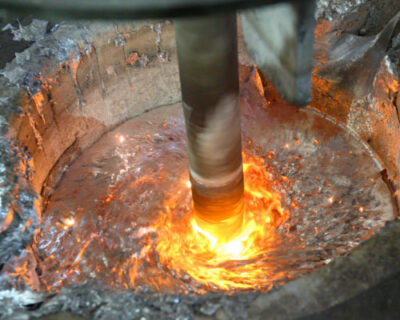Aluminum alloys easily absorb gas and are the main characteristics of cast aluminum alloys. The hydrogen produced by the reaction of the components of the liquid aluminum and aluminum alloy with the moisture contained in the furnace material, the combustion products of organic matter, and the mold is absorbed by the aluminum liquid. How to remove hydrogen in aluminum liquid is the most concern of aluminum foundry.
Hydrogen in Aluminum Liquid
The higher the temperature of the aluminum alloy melt, the more hydrogen absorbed; at 700 ℃, the solubility of hydrogen per 100g of aluminum is 0.5 ~ 0.9, when the temperature is increased to 850 ℃, the solubility of hydrogen increases by 2 to 3 times. When containing alkali metal impurities, the solubility of hydrogen in the aluminum liquid increases significantly.
In addition to gettering during melting, cast aluminum alloys also produce gettering when pouring into the mold. The liquid metal entering the mold decreases with temperature, the solubility of the gas decreases, excess gas is precipitated, and some of the gas cannot escape. Pore holes are formed in the casting, which is commonly referred to as “pinholes”. The gas is sometimes combined with the shrinkage cavity, and the gas precipitated in the aluminum liquid remains in the shrinkage cavity. If the pressure generated by the bubble is large, the surface of the pore is smooth, and there is a circle of bright layers around the pore. If the pressure generated by the bubble is small, the inner surface of the hole is wrinkled and looks like a “fly’s foot”. Careful observation has the characteristics of shrinkage.

The higher the hydrogen content in the aluminum alloy casting liquid, the more pinholes are produced in the casting. Pinholes in aluminum castings not only reduce the airtightness and corrosion resistance of castings, but also reduce the mechanical properties of the alloy. The key to obtaining aluminum castings with no or few pores is the melting conditions. If a covering agent is added during smelting to protect the alloy, the amount of air intake is greatly reduced. Refining the aluminum melt can effectively control the hydrogen content in the aluminum melt.
How to Remove Hydrogen in Aluminum Liquid
At present, in order to eliminate pinholes in aluminum alloy castings, the most common method is to degas chloride salts and chlorides during the melting process, degassing with chlorine and nitrogen, degassing with vacuum, degassing with ultrasonic waves, filtering degassing, etc. AdTech offers the online degassing unit and refining flux for hydrogen removal in aluminum liquid.

